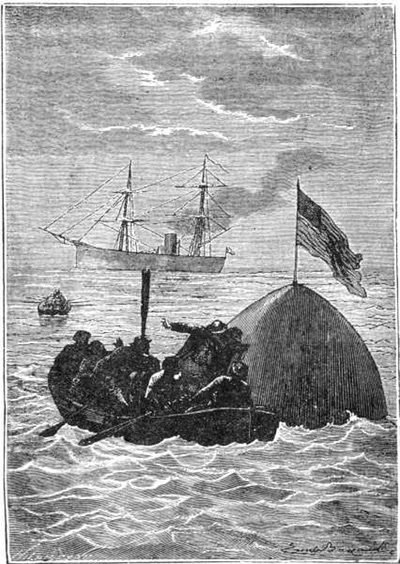Around the Moon, revisitedby Eric R. Hedman
|
| Science fiction has long been the inspiration for the development of scientific reality. Therefore, it is worth going back to look at the original masterpieces of science fiction and how they presaged the Space Age. |
Jules Verne was not the first author of science fiction. There were many who dabbled prior to him. Edgar Allan Poe had written science fiction stories such as The Unparalleled Adventure of One Hans Pfall, which is the story of a man’s journey to the Moon using a balloon a few decades earlier. He tried to base it upon what he knew of science at the time. He also wrote stories about time travel that could be considered part of the genre. After Jules Verne, Mark Twain wrote some stories that are also considered science fiction. Twain wrote a short story in 1898 that predicted something like the internet called From The ‘London Times’ of 1904. In between these two literary giants was Jules Verne. He was a Frenchman who, with the great success of his science fiction novels, established the genre as a real branch of literature.
Science fiction has long been the inspiration for the development of scientific reality. Children growing up reading novels like 20,000 Leagues under the Sea and Around the Moon have been inspired to go invent the future. Therefore, it is worth going back to look at the original masterpieces of science fiction and how they presaged the Space Age.
In the 19th century, our understanding of science and the universe around us was changing rapidly. Charles Darwin had written his masterpiece that holds up like few other scientific works of the era. All the pieces were being put in place to make the technical wonders of the twentieth century possible. It is no wonder that some creative people were considering the possibility that humans could fly to the Moon.
Jules Verne was not a scientist. He was, however, well read on many scientific topics. He tried to use this knowledge to the best of his ability reflecting the state of scientific knowledge of the era.
Jules Verne wrote Around the Moon in the 1860s, a century before the Apollo missions. Knowledge of the Moon was limited to what could be seen in the telescopes of the day and knowledge of gravity and orbital mechanics, and some scientists speculated about its ability to host life.
Jules Verne used his best understanding to put together his concept as to how a mission to the Moon could be undertaken. He probably knew some of his guesses were wrong but used them anyway so he could come up with a plausible story. That is no different than what science fiction writers do today.
| Perhaps the proposed station around the Moon should be called the Jules Verne Gateway Station. He deserves the honor. |
What Jules Verne got right is impressive. His story is about three men who are launched to the Moon from Florida and eventually splash down in the Pacific after circling around the Moon. He predicted it would be Americans who would do it. Sound familiar? In his story the three travelers are inside an airtight projectile that has a system for scrubbing carbon dioxide out of the air. The projectile passes through what we call L-1 where the gravity of the Moon and Earth balance. He has the projectile loop around the Moon in what we call a free return trajectory. During the lunar flyby his characters perform detailed observations of the Moon conducted in a scientific manner. They measure the temperature of what he calls planetary space when they are in the shadow off the Moon on the far side and come up with minus 218 degrees Fahrenheit as a reading. They determine that there is no life nor an atmosphere on the Moon. They observe snow on the mountains of the lunar poles (off by just a little where frozen water would be found.) The crew argues out in a logical manner the conclusions they are making about our nearest neighbor. Considering the state of astronomy at the time, the guesses were pretty good.
There were several things Verne got wrong. There is no way the crew would have survived being launched vertically in a 900-foot cannon due to the immense acceleration required. They also would not have survived reentry in their capsule. They would not have survived impact with the ocean surface without parachutes. Gravity would not have held them to the floor of their projectile during the flight. They would not have been able to open a window to throw out their trash into the vacuum of space and quickly close it before losing too much air. But, then again, there are issues I had with the movie The Martian for technical inaccuracies. That was still a story enjoyed by many.
Around the Moon is an engaging, well-written story. For all of those who read it in your youth, it’s time to read it again. From where we are today if you consider it from the time it was written and everything we have developed along the way since, it is an amazing book. I can imagine all the wide-eyed kids reading this over the past century and a half. I can see how it could easily have inspired many that made our future what it is. Perhaps the space race and Apollo flights to the Moon a century later would never have happened without this book. For that reason alone, I would like to see the proposed station around the Moon called the Jules Verne Gateway Station. Jules Verne deserves the honor. He inspired people to dream about going to the Moon. If you read this book and consider when it was written, I think many of you may agree.
Note: we are temporarily moderating all comments subcommitted to deal with a surge in spam.
